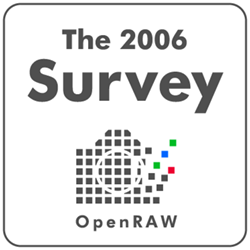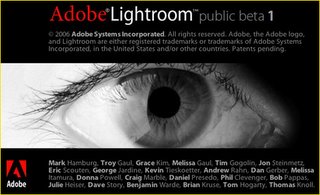
1/31/2006 For Immediate Release — RAW Survey launched: An International Study of the Experiences, Requirements, Preferences, and Concerns of Photographers regarding RAW Imaging Technology.
On January 31, 2006, the OpenRAW initiative launched an international survey on its Web Site to collect information about the experiences, requirements, preferences, and concerns of digital photographers and other interested parties regarding RAW imaging technology — a concept that many writers are comparing to a "digital negative".
RAW Technology Issues
As the digital properties of RAW image files have become better understood, many digital photographers have embraced RAW technology as the best means to obtain maximum image quality for themselves and their clients. However, during the past year many photographers, photo archivists, and others involved in digital imaging have become concerned about the absence of a robust, common standard for RAW image file formats. Faced with a proliferation of proprietary RAW format— often different for each successive camera model from each camera manufacturer— imaging professionals and devoted amateurs have experienced significant disruptions in their digital image workflow and limitations in their choice of software tools.
This expansion of the sheer number of proprietary RAW formats and the adoption by camera manufacturers of the practice of encryption to conceal information stored in RAW image files have increased fears about the viability of RAW formats for the long term archiving of photographic material. Some manufacturers whose cameras produced proprietary RAW files have already gone out of business, with unknown consequences for future access to those images. Many photographers are concerned that RAW files from current camera models may not be accessible in the future when those models are discontinued.
Why a Survey?
Although these topics are being discussed in many photography forums, we have very little systematic information about the experiences, requirements, preferences, and concerns of photographers regarding RAW imaging technology. One thing is clear— many photographers and archivists believe that camera manufacturers are making important decisions about RAW image technology with little or no input from the people who buy and use their equipment or who are involved in the preservation of photographic works. The OpenRAW survey will give photographers and other interested parties an opportunity to have a voice in the further development of RAW imaging technology.
The online survey questionnaire will be available for eight weeks beginning on January 31, 2006. The date was chosen to coincide closely with the 168th anniversary of an address by William Henry Fox Talbot to the Royal Society of London in 1839 describing a process of "photogenic drawing" (the collotype) based on a paper "negative" that would permit unlimited copies of an image to be made.
We encourage everybody with an interest in RAW image formats to visit the OpenRAW website at http://openraw.org/survey/ and to complete the survey questionnaire, which will take approximately 10-15 minutes. All responses will be kept completely anonymous and confidential. The OpenRAW organization and survey have no connection with any business or commercial interest. The purpose of the survey is to give professional and amateur photographers a means to express their requirements, preferences, and concerns which will be made available to camera manufacturers, software development firms, and other key participants in the digital imaging industry.
Results of the survey will be reported at the OpenRAW Web page. We believe good decisions by the digital photography industry should take account of the needs, requirements, and preferences of the photographers who make their living or pursue their artistic vision through this medium. We will share the survey results widely in the hope that the future of the craft will benefit.
For more information please visit the OpenRAW web site: http://www.openraw.org/
The OpenRAW survey sponsors:
Juergen Specht, photographer and founder of the OpenRAW initiative or@openraw.org
Calvin Jones, statistical research consultant ccj@stat-eval.com



